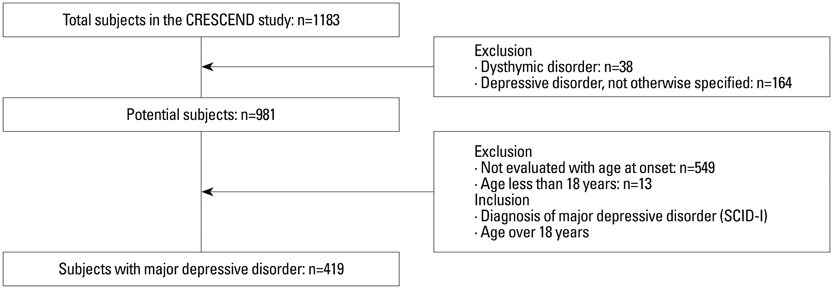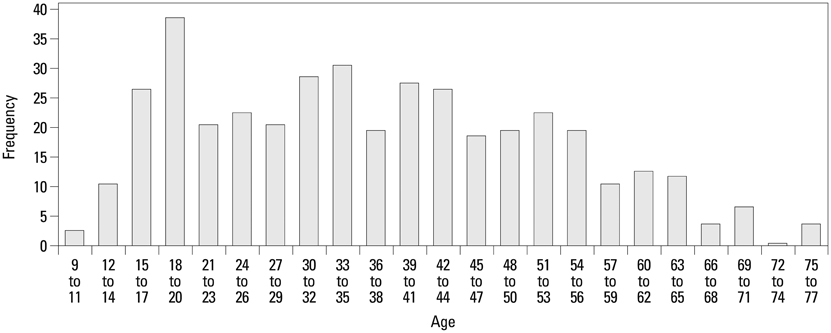Yonsei Med J.
2014 Nov;55(6):1712-1720. 10.3349/ymj.2014.55.6.1712.
Does Age at Onset of First Major Depressive Episode Indicate the Subtype of Major Depressive Disorder?: The Clinical Research Center for Depression Study
- Affiliations
-
- 1Department of Psychiatry, Yong-In Mental Hospital, Yongin, Korea.
- 2Institute of Mental Health, Hanyang University, Seoul, Korea. hypyc@hanyang.ac.kr
- 3Department of Psychiatry, College of Medicine, Soonchunhyang Univeristy, Seoul Hospital, Seoul, Korea.
- 4WHO Collaborating Center for PR and CMH, Yong-In Mental Hospital, Yongin, Korea.
- 5Department of Psychiatry, School of Medicine, Chonnam National University, Gwangju, Korea.
- 6Department of Psychiatry, College of Medicine, The Catholic University of Korea, Seoul, Korea.
- 7Department of Psychiatry, College of Medicine, Korea University, Seoul, Korea.
- 8Department of Psychiatry, Keimyung University School of Medicine, Daegu, Korea.
- 9Department of Preventive Medicine, College of Medicine, The Catholic University of Korea, Seoul, Korea.
- 10Department of Psychiatry, College of Medicine, Hanyang University, Guri Hospital, Guri, Korea.
- KMID: 2070222
- DOI: http://doi.org/10.3349/ymj.2014.55.6.1712
Abstract
- PURPOSE
The purpose of this study was to evaluate the effects of age at onset of the first major depressive episode on the clinical features of individuals with major depressive disorder (MDD) in a large cohort of Korean depressed patients.
MATERIALS AND METHODS
We recruited 419 MDD patients of age over 18 years from the Clinical Research Center for Depression study in South Korea. At the start of the study, the onset age of the first major depressive episode was self-reported by the subjects. The subjects were divided into four age-at-onset subgroups: childhood and adolescent onset (ages <18), early adult onset (ages 18-44), middle adult onset (ages 45-59), and late onset (ages 60+). Using analysis of covariance (ANCOVA) and ordinal logistic regression analysis with adjusting the effect of age, the relationships between clinical features and age at onset of MDD were evaluated.
RESULTS
There was an apparent, but inconsistent correlation between clinical features and age at onset. Earlier onset MDD was significantly associated with higher proportion of female gender [adjusted odds ratio (AOR)=0.570, p=0.022], more previous suicide attempts (AOR=0.635, p=0.038), greater number of previous depressive episodes (F=3.475, p=0.016) and higher scores on the brief psychiatric rating scale (F=3.254, p=0.022), its negative symptom subscale (F=6.082, p<0.0001), and the alcohol use disorder identification test (F=7.061, p<0.0001).
CONCLUSION
Early age at onset may increase the likelihood of distinguishable MDD subtype, and age at onset of the first major depressive episode is a promising clinical indicator for the clinical presentation, course, and outcome of MDD.
MeSH Terms
Figure
Cited by 1 articles
-
Potential Relationship between Season of Birth and Clinical Characteristics in Major Depressive Disorder in Koreans: Results from the CRESCEND Study
Seon-Cheol Park, Jeong-Kyu Sakong, Bon Hoon Koo, Jae-Min Kim, Tae-Youn Jun, Min-Soo Lee, Jung-Bum Kim, Hyeon-Woo Yim, Yong Chon Park
Yonsei Med J. 2016;57(3):784-789. doi: 10.3349/ymj.2016.57.3.784.
Reference
-
1. Seok JH, Lee KU, Kim W, Lee SH, Kang EH, Ham BJ, et al. Impact of early-life stress and resilience on patients with major depressive disorder. Yonsei Med J. 2012; 53:1093–1098.
Article2. Kendler KS, Kessler RC, Walters EE, MacLean C, Neale MC, Heath AC, et al. Stressful life events, genetic liability, and onset of an episode of major depression in women. Am J Psychiatry. 1995; 152:833–842.
Article3. Paykel ES. Classification of depressed patients: a cluster analysis derived grouping. Br J Psychiatry. 1971; 118:275–288.
Article4. Lichtenberg P, Belmaker RH. Subtyping major depressive disorder. Psychother Psychosom. 2010; 79:131–135.
Article5. Zhu T, De Luca V, Gallaugher LA, Woldeyohannes HO, Soczynska JK, Szymkowicz S, et al. Admixture analysis of age at onset in major depressive disorder. Gen Hosp Psychiatry. 2012; 34:686–691.
Article6. Jaffee SR, Moffitt TE, Caspi A, Fombonne E, Poulton R, Martin J. Differences in early childhood risk factors for juvenile-onset and adult-onset depression. Arch Gen Psychiatry. 2002; 59:215–222.
Article7. Zisook S, Rush AJ, Albala A, Alpert J, Balasubramani GK, Fava M, et al. Factors that differentiate early vs. later onset of major depression disorder. Psychiatry Res. 2004; 129:127–140.
Article8. Zisook S, Rush AJ, Lesser I, Wisniewski SR, Trivedi M, Husain MM, et al. Preadult onset vs. adult onset of major depressive disorder: a replication study. Acta Psychiatr Scand. 2007; 115:196–205.
Article9. Yang F, Li Y, Xie D, Shao C, Ren J, Wu W, et al. Age at onset of major depressive disorder in Han Chinese women: relationship with clinical features and family history. J Affect Disord. 2011; 135:89–94.
Article10. Muhonen LH, Lönnqvist J, Lahti J, Alho H. Age at onset of first depressive episode as a predictor for escitalopram treatment of major depression comorbid with alcohol dependence. Psychiatry Res. 2009; 167:115–122.
Article11. Frank MG, Wieseler Frank JL, Hendricks SE, Burke WJ, Johnson DR. Age at onset of major depressive disorder predicts reductions in NK cell number and activity. J Affect Disord. 2002; 71:159–167.
Article12. Benazzi F. Classifying mood disorders by age-at-onset instead of polarity. Prog Neuropsychopharmacol Biol Psychiatry. 2009; 33:86–93.
Article13. Park SC, Kim JM, Jun TY, Lee MS, Kim JB, Jeong SH, et al. Prevalence and clinical correlates of insomnia in depressive disorders: The CRESCEND Study. Psychiatry Investig. 2013; 10:373–381.
Article14. American Psychiatric Association. Diagnostic and Statistical Manual of Mental Disorders. 4th ed. Washington DC: American Psychiatric Press;1994.15. First MB, Spitzer RL, Gibbon M, Williams JBW. Structured Clinical Interview for DSM-IV Axis I Disorders-Patient Edition (SCID-I/P, Version 2.0). New York: Biometrics Research Department, New York State Psychiatric Institute;1995.16. Farrer LA, Florio LP, Bruce ML, Leaf PJ, Weissman MM. Reliability of self-reported age at onset of major depression. J Psychiatr Res. 1989; 23:35–47.
Article17. Prusoff BA, Merikangas KR, Weissman MM. Lifetime prevalence and age of onset of psychiatric disorders: recall 4 years later. J Psychiatr Res. 1988; 22:107–117.
Article18. Zisook S, Lesser I, Stewart JW, Wisniewski SR, Balasubramani GK, Fava M, et al. Effect of age at onset on the course of major depressive disorder. Am J Psychiatry. 2007; 164:1539–1546.
Article19. Hamilton M. A rating scale for depression. J Neurol Neurosurg Psychiatry. 1960; 23:56–62.
Article20. Hamilton M. The assessment of anxiety states by rating. Br J Med Psychol. 1959; 32:50–55.
Article21. Overall JE, Gorham DR. The brief psychiatric rating scale. Psychol Rep. 1962; 10:779–812.
Article22. Guy W. U.S. Department of Health, Education, and Welfare Publication. ECDEU Assessment Manual for Psychopharmacology. Washington DC: National Institute of Mental Health;1976.23. Goldman HH, Skodol AE, Lave TR. Revising axis V for DSM-IV: a review of measures of social functioning. Am J Psychiatry. 1992; 149:1148–1156.
Article24. Beck AT, Kovacs M, Weissman A. Assessment of suicidal intention: the Scale for Suicide Ideation. J Consult Clin Psychol. 1979; 47:343–352.
Article25. The WHOQOL Group. Development of the World Health Organization WHOQOL-BREF quality of life assessment. Psychol Med. 1998; 28:551–558.26. Saunders JB, Aasland OG, Babor TF, de la Fuente JR, Grant M. Development of the Alcohol Use Disorders Identification Test (AUDIT): WHO Collaborative Project on Early Detection of Persons with Harmful Alcohol Consumption--II. Addiction. 1993; 88:791–804.
Article27. Yi JS, Bae SO, Ahn YM, Park DB, Noh KS, Shin HK, et al. Validity and reliability of the Korean Version of the Hamilton Depression Rating Scale(K-HDRS). J Korean Neuropsychiatr Assoc. 2005; 44:456–465.28. Lee JY, Cho MJ, Kwon JS. Global Assessment of Functioning Scale and Social and Occupational Functioning Scale. Korean J Psychopharmacol. 2006; 17:122–127.29. Joe KH, Chai SH, Park A, Lee HK, Shin IH, Min SH. Optimum cut-off score for screening of hazardous drinking using the Korean version of Alcohol Use Disorder Identification Test (AUDIT-K). J Korean Academy of Addiction Psychiatry. 2009; 13:34–40.30. Wilkowska-Chmielewska J, Szelenberger W, Wojnar M. Age-dependent symptomatology of depression in hospitalized patients and its implications for DSM-5. J Affect Disord. 2013; 150:142–145.
Article31. Galynker II, Cai J, Ongseng F, Finestone H, Dutta E, Serseni D. Hypofrontality and negative symptoms in major depressive disorder. J Nucl Med. 1998; 39:608–612.32. Galynker II, Cohen LJ, Cai J. Negative symptoms in patients with major depressive disorder: a preliminary report. Neuropsychiatry Neuropsychol Behav Neurol. 2000; 13:171–176.33. Nurnberger JI Jr, Foroud T, Flury L, Su J, Meyer ET, Hu K, et al. Evidence for a locus on chromosome 1 that influences vulnerability to alcoholism and affective disorder. Am J Psychiatry. 2001; 158:718–724.
Article34. Lyons MJ, Schultz M, Neale M, Brady K, Eisen S, Toomey R, et al. Specificity of familial vulnerability for alcoholism versus major depression in men. J Nerv Ment Dis. 2006; 194:809–817.
Article35. Gokturk C, Schultze S, Nilsson KW, von Knorring L, Oreland L, Hallman J. Serotonin transporter (5-HTTLPR) and monoamine oxidase (MAOA) promoter polymorphisms in women with severe alcoholism. Arch Womens Ment Health. 2008; 11:347–355.
Article36. Alpert JE, Fava M, Uebelacker LA, Nierenberg AA, Pava JA, Worthington JJ 3rd, et al. Patterns of axis I comorbidity in early-onset versus late-onset major depressive disorder. Biol Psychiatry. 1999; 46:202–211.
Article37. Klein DN, Schatzberg AF, McCullough JP, Dowling F, Goodman D, Howland RH, et al. Age of onset in chronic major depression: relation to demographic and clinical variables, family history, and treatment response. J Affect Disord. 1999; 55:149–157.
Article38. Korten NC, Comijs HC, Lamers F, Penninx BW. Early and late onset depression in young and middle aged adults: differential symptomatology, characteristics and risk factors? J Affect Disord. 2012; 138:259–267.
Article
- Full Text Links
- Actions
-
Cited
- CITED
-
- Close
- Share
- Similar articles
-
- The Association Study between Mood Disorder Questionnaire and Bipolar Spectrum Disorder in Major Depressive Disorder
- Characteristics of major depressive disorder according to family history of depression : A CRESCEND-K (Clinical Research Center for Depression in Korea) study
- Prevalence and Associated Factors of Depression in Mild Cognitive Impairment
- Korean Clinical Practice Guideline for the Treatment of Depressive Disorders: The Present State and Future Direction of Development
- Comparison of Clinical Symptoms between Early and Late Onset Depression in Elderly Depressive Patients in Korea




